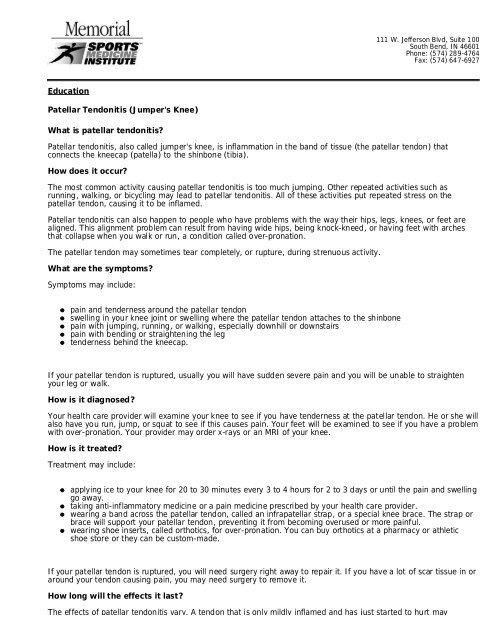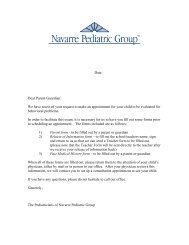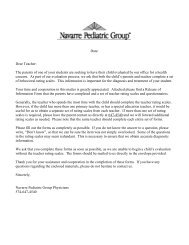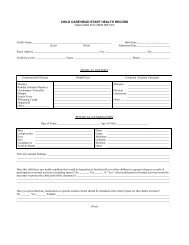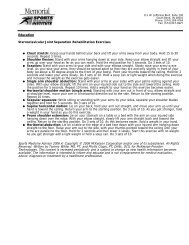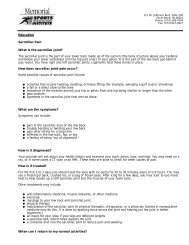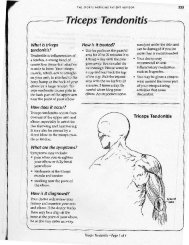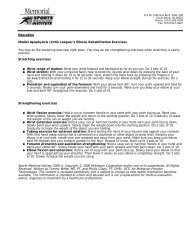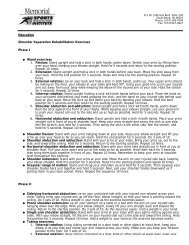What is patellar tendonitis? - Memorial Medical Group
What is patellar tendonitis? - Memorial Medical Group
What is patellar tendonitis? - Memorial Medical Group
Create successful ePaper yourself
Turn your PDF publications into a flip-book with our unique Google optimized e-Paper software.
111 W. Jefferson Blvd, Suite 100South Bend, IN 46601Phone: (574) 289-4764Fax: (574) 647-6927EducationPatellar Tendonit<strong>is</strong> (Jumper's Knee)<strong>What</strong> <strong>is</strong> <strong>patellar</strong> tendonit<strong>is</strong>?Patellar tendonit<strong>is</strong>, also called jumper's knee, <strong>is</strong> inflammation in the band of t<strong>is</strong>sue (the <strong>patellar</strong> tendon) thatconnects the kneecap (patella) to the shinbone (tibia).How does it occur?The most common activity causing <strong>patellar</strong> tendonit<strong>is</strong> <strong>is</strong> too much jumping. Other repeated activities such asrunning, walking, or bicycling may lead to <strong>patellar</strong> tendonit<strong>is</strong>. All of these activities put repeated stress on the<strong>patellar</strong> tendon, causing it to be inflamed.Patellar tendonit<strong>is</strong> can also happen to people who have problems with the way their hips, legs, knees, or feet arealigned. Th<strong>is</strong> alignment problem can result from having wide hips, being knock-kneed, or having feet with archesthat collapse when you walk or run, a condition called over-pronation.The <strong>patellar</strong> tendon may sometimes tear completely, or rupture, during strenuous activity.<strong>What</strong> are the symptoms?Symptoms may include:pain and tenderness around the <strong>patellar</strong> tendonswelling in your knee joint or swelling where the <strong>patellar</strong> tendon attaches to the shinbonepain with jumping, running, or walking, especially downhill or downstairspain with bending or straightening the legtenderness behind the kneecap.If your <strong>patellar</strong> tendon <strong>is</strong> ruptured, usually you will have sudden severe pain and you will be unable to straightenyour leg or walk.How <strong>is</strong> it diagnosed?Your health care provider will examine your knee to see if you have tenderness at the <strong>patellar</strong> tendon. He or she willalso have you run, jump, or squat to see if th<strong>is</strong> causes pain. Your feet will be examined to see if you have a problemwith over-pronation. Your provider may order x-rays or an MRI of your knee.How <strong>is</strong> it treated?Treatment may include:applying ice to your knee for 20 to 30 minutes every 3 to 4 hours for 2 to 3 days or until the pain and swellinggo away.taking anti-inflammatory medicine or a pain medicine prescribed by your health care provider.wearing a band across the <strong>patellar</strong> tendon, called an infra<strong>patellar</strong> strap, or a special knee brace. The strap orbrace will support your <strong>patellar</strong> tendon, preventing it from becoming overused or more painful.wearing shoe inserts, called orthotics, for over-pronation. You can buy orthotics at a pharmacy or athleticshoe store or they can be custom-made.If your <strong>patellar</strong> tendon <strong>is</strong> ruptured, you will need surgery right away to repair it. If you have a lot of scar t<strong>is</strong>sue in oraround your tendon causing pain, you may need surgery to remove it.How long will the effects it last?The effects of <strong>patellar</strong> tendonit<strong>is</strong> vary. A tendon that <strong>is</strong> only mildly inflamed and has just started to hurt may
improve within a few weeks. A tendon that <strong>is</strong> significantly inflamed and has been painful for a long time may takeup to a few months to improve. You need to stop doing the activities that cause pain until your tendon has healed.If you continue doing activities that cause pain, your symptoms will return and it will take longer to recover.When can I return to my normal activities?Everyone recovers from an injury at a different rate. Return to your activities will be determined by how soon yourknee recovers, not by how many days or weeks it has been since your injury has occurred. In general, the longeryou have symptoms before you start treatment, the longer it will take to get better. The goal of rehabilitation <strong>is</strong> toreturn you to your normal activities as soon as <strong>is</strong> safely possible. If you return too soon you may worsen your injury.You may safely return to your normal activities when, starting from the top of the l<strong>is</strong>t and progressing to the end,each of the following <strong>is</strong> true:Your injured knee can be fully straightened and bent without pain.Your knee and leg have regained normal strength compared to the uninjured knee and leg.Your knee <strong>is</strong> not swollen.You are able bend, walk, and squat without pain.How can I prevent <strong>patellar</strong> tendonit<strong>is</strong>?Patellar tendonit<strong>is</strong> <strong>is</strong> usually caused by overuse during activities such as jumping or running or biking uphill. It canbest be prevented by having strong thigh muscles.The following may also help prevent injury:When you exerc<strong>is</strong>e, wear shoes that fit properly and are right for the activity.Gently stretch before and after exerc<strong>is</strong>ing.Sports Medicine Adv<strong>is</strong>or 2006.4; Copyright © 2006 McKesson Corporation and/or one of its subsidiaries. All RightsReserved. Written by Pierre Rouzier, M.D., for McKesson Provider Technologies. Th<strong>is</strong> content <strong>is</strong> reviewed periodicallyand <strong>is</strong> subject to change as new health information becomes available. The information <strong>is</strong> intended to inform andeducate and <strong>is</strong> not a replacement for medical evaluation, advice, diagnos<strong>is</strong> or treatment by a healthcareprofessional.


